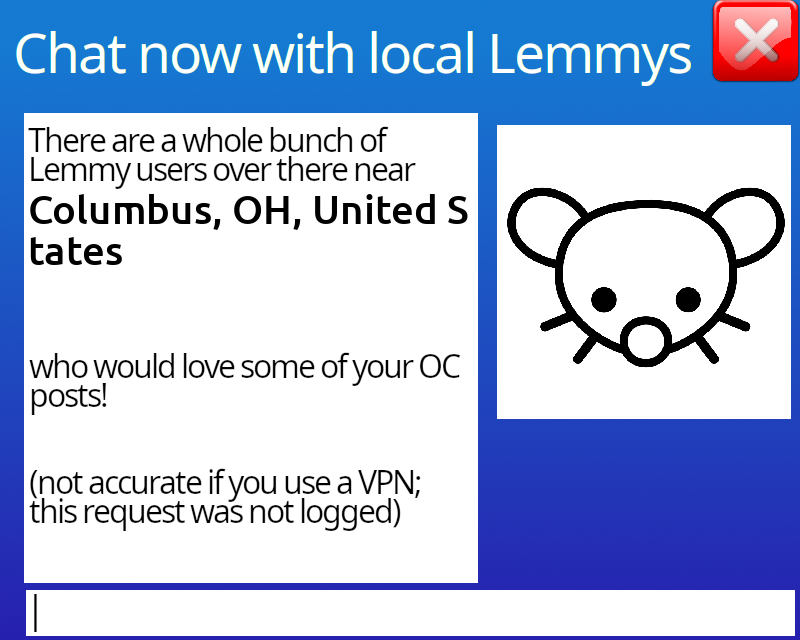

Giver of skulls





Email federates across providers. As do voice calls, texts, and RCS. The telecom industry was forced to do some kind of federation the moment different countries (with different monopolies) started needing to call each other. The terrible, terrible signalling systems that made this federation possible still allow for foreign governments to track human rights activists and journalists across the border today. The modern telecoms federation system is better, but it’ll only protect you when everyone in the world stops doing 2G and that’ll take another decade at least.
Back when newsgroups existed in serious numbers (not for piracy reasons) they were a major federated discussion forum. IRC chats were and still are federated, though not many interconnected IRC channels remain.
There used to be this “OpenID” standard that was designed to be federated. Basically, you registered an account with any identity server, and with the URL to that server you could log in to any service that used federated OpenID. That way, websites didn’t need to bother registering passwords and such, and you only needed to enter your password with an identity server of your choice. Great concept, never got any real interest, died out slowly, now you can’t even find information about it any more. OAuth2 rose from its rotting remains at some point.
RSS is a semi-federated protocol, as are Atom feeds, its successor. You don’t really send much data to these servers, but it does allow you to follow arbitrary web pages or people. If you’ve ever subscribed to a podcast using a third party app or website, you’ve probably accidentally used either Atom or RSS.
WordPress had this network of pingbacks that would share when one blog mentioned another, which worked across servers and domains just like a federated system.
In the 00s there were these special walkie-talkies that would set up an independent mesh network to communicate without cell service or internet connectivity. That was more peer to peer than federation, I guess, but it’s a pretty cool invention that was only used to send messages between Barbie coloured pieces of plastic.
Modern federated networks you may not know about include XMPP and Matrix for messaging, probably a system of interconnected patient databases if your government deals with healthcare, and I think the EU system that’ll let you log in to foreign government websites using your own government’s digital IT system could also be considered federated.
Bluesky is technically federated over ATProto and through bridges like bridgy fed you can set up bidirectional communications between the Fediverse and the ATProtoverse.


If your connection is technically capable of matching upload and download speeds, you can usually just pay more for higher speeds. Basically, if you’re on fiber or one of those super rare long distance ethernet connections. Synchronous fiber is more expensive (because you’re getting more and planned egress data+capacity is more expensive than ingress data+capacity).
If you’re on 4G/5G/coax, there are very good technical reasons why matching upload and download speeds is impractical. Possible, yes, but the total throughput of the entire network would be significantly lower, because half the network’s capacity would need to be reserved just in case someone in your neighborhood is uploading a video to TikTok. Sending data to you is easy, reserving time for everyone to claim an upload slot involves spreading bits across a multi dimensional grid consisting of things like time/frequency/phase across a probability grid with grid blocks as small as 62 microseconds in size (in the time dimension). You can’t set up a shared medium like that without either wasting most of the bandwidth or putting a central controller in place, with most of the bandwidth at their disposal.
Sometimes cable ISPs do alter their frequency plans to reserve more upload capacity. Often this coincides with free analog services such as radio and TV getting killed off because they’re hogging important parts of the spectrum. Sometimes everyone gets a bit more latency and a bit less download capacity to accommodate for the higher upload. Most of the time you need to replace/update your modem to make use of any of the advantages and most people usually don’t bother even if they could use more upload capacity.
If you’re on DSL (which goes up to what, 400mbps these days?) then the ancient dark witchcraft sending more than 28.8k down a rusty old phone line specced for the late 1800s should not be questioned. Praise be to the dark lords of telecommunication for the ungodly arcane rituals those fuckers pull to send broadband internet over those lines at all.